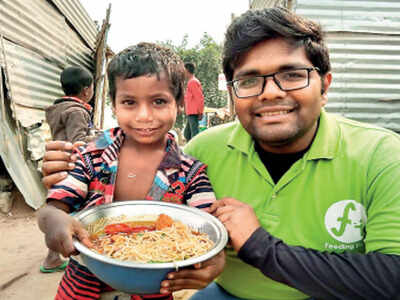
MUMBAI: At the cappuccino outlets near airport boarding gates, every morning about 200 sandwiches, 100 rolls, 50 soft drinks and more are stacked in glass chillers awaiting passengers who will have their breakfast on the go. If an aircraft is grounded and the flight delayed, the sandwiches fly off the shelf. But if a flight has been cancelled in advance, passengers don’t turn up, footfalls dip and there are fewer takers for the morning grub. The ebb and flow of passengers leads to a shortage of meals on some days and excess food with no takers on most days.
Which is why for the past several months, a food truck pulls into Mumbai and Delhi airports daily to take away these excess meals. TFS (Travel Food Services), the company that runs 70 restaurants, lounges and food and beverage outlets at Mumbai and Delhi airports, has tied up with an NGO, Feeding India, to donate the unsold from these airports to the “hunger centres” of both these cities.
The initiative began with Mumbai in October last year and then Delhi in January. “We plan to expand the tie-up with Feeding India to airports like Bengaluru, Chennai, Kolkata and Goa this year,’’ said Gaurav Dewan, COO and business head, TFS. He said that they donate anywhere between 2,000 and 3,000 meals per month from these two airports.
NGO hopes to get airlines on board next
“At every airport, we cater to various flight times and various traffic peaks and off-peaks. Since there is no specific pattern to the flight delays and cancellations, every day we end up with extra meals. We have been donating 1,000-1,500 meals per month from each of the two airports,’’ Dewan said.
At the end of their shift, TFS employees carve out an extra half hour to personally contribute to this venture. “The food truck comes in the morning and sometimes in the evening too. We have a designated pick-up stop, for instance it’s near our kitchen in Mumbai T1,” he said.
Ankit Kawatra, founder of Feeding India, said, “Before we pick up the food, we ensure it is fresh and unused. There are certain quality checks like PH value that we take into consideration. Also, the beneficiary must be located within a radius of five kilometres so that transportation time is shorter and the food is consumed within 90 minutes.”
Kawatra began the NGO in 2014, a product of an eventful evening—he was a guest at a lavish wedding where he learned from the caterer that food enough to feed thousands of people would be thrown away. Months later he had quit his job at a global business advisory firm and Feeding India took off by tying up with a restaurants and cafeterias. But airports came up on the hunger radar only last year.
“For decades, tonnes of cooked food from airport lounges and restaurants has been going into the bin. In western countries, it’s the standard norm for airlines and airports to donate excess food. But there is a lack of awareness in India. With our partnership with Mumbai and Delhi airports, we hope to reach airlines too,” he said.
After the food if tested and collected from airports, the NGO matches and puts together a balanced meal with curry, vegetable, rice, roti, one beverage and, on some days, desserts. “Food from TFS lounges is distributed to children who are not part of government schools or it goes to shelters and charitable schools with no access to mid-day meals,” he said.
“In Mumbai, the food is distributed to a welfare society in Goregaon. We put that place on our map after the Mumbai airport came on board,’’ said Kawatra. According to UN estimates, 40% of the food produced in India—at different stages from harvesting to consumption—is either lost or wasted.
“The best thing about the concept is it starts with one meal being served to a child in school. As the child grows up, the meal ensures he/she continues to attend the school,” he said. “Every city has a number of ‘hunger spots’; places where people are starving. Then there are places that produce excess food,’’ said Kawatra.
The initiative is simply about connecting these two. And Indian airports are finally doing that.
Which is why for the past several months, a food truck pulls into Mumbai and Delhi airports daily to take away these excess meals. TFS (Travel Food Services), the company that runs 70 restaurants, lounges and food and beverage outlets at Mumbai and Delhi airports, has tied up with an NGO, Feeding India, to donate the unsold from these airports to the “hunger centres” of both these cities.
The initiative began with Mumbai in October last year and then Delhi in January. “We plan to expand the tie-up with Feeding India to airports like Bengaluru, Chennai, Kolkata and Goa this year,’’ said Gaurav Dewan, COO and business head, TFS. He said that they donate anywhere between 2,000 and 3,000 meals per month from these two airports.
NGO hopes to get airlines on board next
“At every airport, we cater to various flight times and various traffic peaks and off-peaks. Since there is no specific pattern to the flight delays and cancellations, every day we end up with extra meals. We have been donating 1,000-1,500 meals per month from each of the two airports,’’ Dewan said.
At the end of their shift, TFS employees carve out an extra half hour to personally contribute to this venture. “The food truck comes in the morning and sometimes in the evening too. We have a designated pick-up stop, for instance it’s near our kitchen in Mumbai T1,” he said.
Ankit Kawatra, founder of Feeding India, said, “Before we pick up the food, we ensure it is fresh and unused. There are certain quality checks like PH value that we take into consideration. Also, the beneficiary must be located within a radius of five kilometres so that transportation time is shorter and the food is consumed within 90 minutes.”
Kawatra began the NGO in 2014, a product of an eventful evening—he was a guest at a lavish wedding where he learned from the caterer that food enough to feed thousands of people would be thrown away. Months later he had quit his job at a global business advisory firm and Feeding India took off by tying up with a restaurants and cafeterias. But airports came up on the hunger radar only last year.
“For decades, tonnes of cooked food from airport lounges and restaurants has been going into the bin. In western countries, it’s the standard norm for airlines and airports to donate excess food. But there is a lack of awareness in India. With our partnership with Mumbai and Delhi airports, we hope to reach airlines too,” he said.
After the food if tested and collected from airports, the NGO matches and puts together a balanced meal with curry, vegetable, rice, roti, one beverage and, on some days, desserts. “Food from TFS lounges is distributed to children who are not part of government schools or it goes to shelters and charitable schools with no access to mid-day meals,” he said.
“In Mumbai, the food is distributed to a welfare society in Goregaon. We put that place on our map after the Mumbai airport came on board,’’ said Kawatra. According to UN estimates, 40% of the food produced in India—at different stages from harvesting to consumption—is either lost or wasted.
“The best thing about the concept is it starts with one meal being served to a child in school. As the child grows up, the meal ensures he/she continues to attend the school,” he said. “Every city has a number of ‘hunger spots’; places where people are starving. Then there are places that produce excess food,’’ said Kawatra.
The initiative is simply about connecting these two. And Indian airports are finally doing that.
Quick Links
Lok Sabha Election Schedule 2019Lok Sabha Election NewsDelhi Capitals teamMI team 2019Rajasthan Royals 2019RCB team 2019Maharashtra Lok Sabha ConstituenciesBJP Candidate ListBJP List 2019 TamilnaduShiv Sena List 2019AP BJP List 2019Mamata BanerjeeBJP List 2019 MaharashtraPriyanka GandhiBJP List 2019 KarnatakaAMMK Candidate List 2019BJP List 2019 WBLok Sabha Elections in Tamil NaduBSP List 2019 UPNews in TamilLok Sabha Poll 2019Satta Matka 2018PM ModiMahagathbandhanNagpur BJP Candidate ListChandrababu NaiduTamil Nadu ElectionsUrmila MatondkarNews in TeluguMadras High CourtTejashwi YadavArvind KejriwalTejasvi SuryaPawan KalyanArvind KejriwalYogi AdityanathJaya PradaSatta King 2019Srinagar encounter
Get the app







